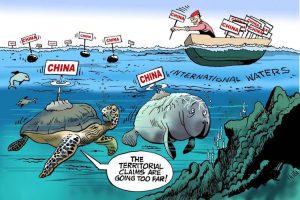Policy 101 : The inception of SEA dispute saga

Modern Borders
A picture of modern China may remind you of the shape of a rooster, and it is a source of dignity for many Chinese. However, over the last 200 years, China’s borders have shifted a number of times due to war. Changes within politics and leadership, have lead to China’s official size, which is currently almost 9.6 million square kilometres. Despite Beijing’s claims to several areas, some of these territorial disagreements go back decades even centuries.

Aksai Chin
In the west, China and India both claim areas controlled by the other as their own. China says Arunachal Pradesh is actually part of southern Tibet, whilst India says Aksai Chin is part of Ladakh. The total of these disputed areas add up to 120 000 square kilometres of land. So how did this all start the dispute? Back in 1914, the representatives from British ruled India and Tibet negotiated the similar convention.
They agreed on a de facto border in the east which they called the McMahon line. New Delhi considers it was the effective border between India and China, but Beijing has never agreed to recognize the line. During 1962, Chinese troops crossed the McMahon line in the east, and won a four-week war against India. India says China occupied about 43000km² of its territory in the west, despite warming relations over the years. This is a territory which China calls “Aksai Chin”.
Negotiations and temporary truces
The countries have never been able to agree on an official border. Instead, they reached a temporary truce along what is known as the “line of actual control”. Conflict still erupts from time to time, with both armies accusing the other of breaches over the past five decades of different Chinese and Russian leaders. Then, in mid-June of 2020 tensions boiled over when Chinese and Indian troops clashed with deadly consequences.

Both sides agreed in 1996 to ban firearms and explosives in the disputed region. The soldiers attacked each other with bare fists and clubs spiked with nails and wrapped in barbed wire. India says at least 20 of its soldiers were killed and 76 injured. China hasn’t confirmed its casualties, but admitted its troops sustained minor injuries off china’s east coast. There has been a long-running dispute over this archipelago, made up of five tiny islets and three barren rocks.
Archipelago
China calls them the Jiayu islands, but Japan (who currently control the area) calls them the Senkaku islands. However they’re also not the only ones with a claim. The self-ruled island of Taiwan says the archipelago is part of its territory, and calls it the Diyutai. China controlled the islands until 1895. Japan seized them at the end of the first Sino Japanese war, after Japan’s surrender to allied forces. At the end of World War II under the treaty of San Francisco, Tokyo returned most of the territory it seized from China. These islands were left out of the agreement. China now ending a war of more than eight years, instead, the United States controlled them until 1972. They were eventually turned over to Japan, along with Okinawa and other surrounding islands.
Since then, regaining control of the Archipelago has been a point of national pride for many people from mainland China. China, Hong Kong, and Taiwan have organised campaigns to sail in the waters near the islands. They’ve even tried to land on one to assert Chinese sovereignty. The situation intensified in 2012 after the Japanese government bought back three of the islands which had been sold to a family.
Demonstrations
In 1932, demonstrations spread across mainland China, with protesters targeting Japanese retail outlets and products. Thousands laid siege to the Japanese embassy in Beijing, throwing bottles and rocks. China also stepped up its presence in waters near the islands, and set up an air defence identification zone that overlapped that of Japan’s.
Although relations between the countries have improved since then, the dispute over the island chain remains unresolved. China’s territorial disputes with its neighbours are not just over islands and land, the country is embroiled in disputes with many of its southeast Asian neighbours, over the South China Sea. China claims nearly all of the sea as its territory, pointing to a nine-dash line that first appeared on Chinese maps in 1953. However, the Philippines, Vietnam, Brunei, Taiwan, and Malaysia, also claim parts of these waters as their own.
China has been criticized for developing military bases, on islands and shoals in the disputed waters. The United States has sought to counter China’s influence, by routinely sending naval vessels to the region, on what it calls “freedom of navigation exercises”. The risk of conflict remains throughout history.

Disputes
China has shown that territorial disputes can be resolved through diplomacy. It regained control of Hong Kong from the British in 1997, and Macau from the Portuguese in 1999. It has also resolved disputes with Tajikistan, Russia, Afghanistan, Pakistan, Myanmar, and North Korea, to either settle borders, regain territory, or jointly develop area. The recent violence on the disputed border with India, with increasing military activity in the South China sea, and the island dispute with Japan, highlights one major question – Can China keep it’s remaining territory?
Source of Writing this Article
- Ikenberry, J. G. (2008). The Rise of China and the Future of the West. Foreign Affairs, 87(1), 23-37.
- International Institute for Strategic Studies, 2014. “Asia” in The Military Balance. 114 (1): 201-296.
- Diamond, J. (2005). Collapse: How Societies Choose to Fail or Succeed (New York: Penguin Group) 275.
- Levy, Jack S. 2011. Theories and Causes of War. United Kingdom: Edward Elgae
- Zhao, H., 2012. “Sino-Philippines Relations: Moving Beyond South China Sea Dispute?”. The Journal of East Asian Affairs, 26(2): 57-76.
- https://www.washingtonpost.com/wp-dyn/articles/A32353-2005Mar13.html






